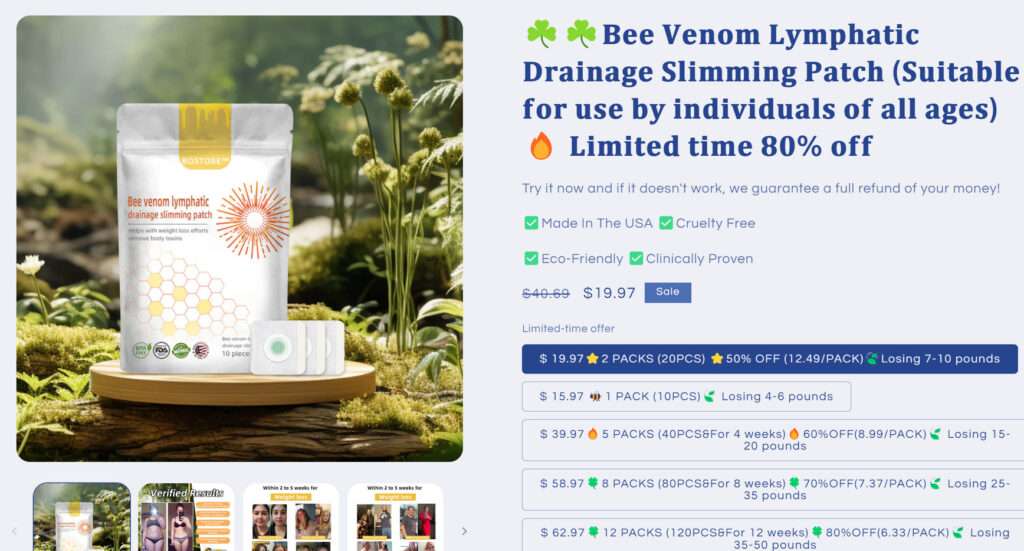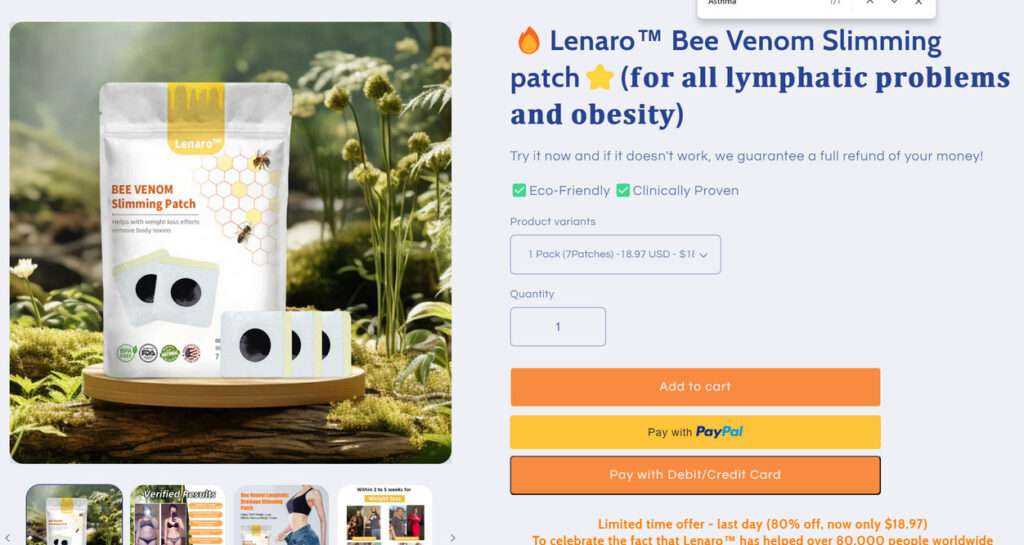Have you seen those viral ads for bee venom slimming patches claiming to painlessly shed massive weight? Before you get stung by the hype, know the unfiltered truth.
As a writer investigating scams, I dove into the sensational world of bee venom patches. Promising effortless fat burning from just sticking on the painless patches seems too good to be true.
Are these products medical marvels or just cunning scams? My investigation uncovered the harsh realities concealed behind the raving reviews and dramatic photos.
I analyzed exaggerated claims, questionable ingredients, dangerous side effects, and predatory tactics exposing the deception. This report aims to help you make informed decisions, avoiding traps promising weight loss miracles.
Join me in navigating the wild promises and hidden perils of these trendy bee venom patches taking social media by storm. You’ll emerge better equipped to protect your health, safely meet goals, and avoid online scammers fabricating dreams out of toxic lies.



This Article Contains:
How Do These Scams Work?
The numerous ads for bee venom slimming patches on Facebook, TikTok, and Instagram feature incredible stories of people losing up to 50 pounds in a month just by using the patches. Comments from “users” and fake celebrity endorsements further hype up the products.
However, there are several red flags that point to these being complete scams:
- The ads never mention brand names and there are no official product websites, only shady ecommerce stores
- The patches are marketed under different names like Lenaro, Cvreoz, and Ceoerty to avoid easy identification
- The before-and-after pictures showing dramatic weight loss are often stolen or photoshopped
- The raving reviews seem fabricated and use stock photos of random people as profile pictures
- The ads emphasize “limited time offers” and “only 5 left!” to create false urgency
In reality, these bee venom patch brands are manufactured by anonymous Chinese companies without any quality oversight. They exploit deceptive marketing techniques to make profits from consumers desperately seeking weight loss miracles.
Outlandish Claims and Pseudoscience Lure Customers
The marketing for bee venom slimming patches is centered around outlandish claims that exploit common insecurities people have about excess weight and poor body image.
The ads target people struggling to lose weight through diet and exercise by claiming the patches provide an almost effortless solution. According to them, just by wearing the patches, the ingredients will melt away fat without any need to diet or exercise.
The commonly advertised pseudoscientific claims about bee venom slimming patches include:
- Burning away 50+ pounds of stubborn fat in just 4 weeks
- Eliminating fat by enhancing lymphatic drainage to detox the body
- Activating powerful hormones to boost metabolism and suppress appetite
- Reducing cellulite and smoothing the skin
- Lowering cholesterol, regulating blood sugar, improving heart health
Of course, no topical patches have such potent effects on the internal metabolic, lymphatic, and hormonal systems as claimed. But exaggerating the benefits is a key strategy to get more sales from customers.
Questionable Ingredients Offer No Real Benefits
Analysis of the ingredients in bee venom slimming patches further confirms the lack of efficacy for such outlandish claims. The main ingredients advertised are:
Bee Venom: While bee venom does have potential uses in medicine, the miniscule amounts in the patches can’t cause substantial weight loss. Topical application does not allow significant absorption into the lymphatic system either.
Black Pepper Extract: May mildly boost metabolism but has negligible effects on weight loss. Certainly does not “burn fat” as claimed.
Peppermint Oil: Provides a cooling, soothing sensation but has no proven benefits for weight loss or lymph drainage.
Ginger and Milk Thistle: Herbs with mild benefits for digestion and liver health but no direct impact on fat burning.
Iceplant Extract: No evidence for the claimed effects of inhibiting fat cells and preventing weight gain.
So the ingredients present no realistic mechanism by which the patches can burn significant fat or detox the lymphatics. The promises of extreme weight loss are medically unsupported.
Adverse Reactions and Allergic Risks
Application of bee venom, especially in untested and unknown amounts, poses risks of allergic reactions like rashes, swelling, and even life-threatening anaphylaxis in sensitive individuals.
Numerous customers have reported experiencing skin irritation, peeling, blisters, headaches, nausea, diarrhea, and facial swelling after using bee venom slimming patches.
The manufacturers provide no safety warnings or usage guidelines. The uncontrolled venom concentrations could easily trigger dangerous allergies, especially with prolonged use.
Absence of Regulation and Oversight
These scams also raise concerns due to the complete lack of regulation, testing, and oversight.
Bee venom is classified as a drug active ingredient by the FDA and its quality and safety for use require thorough testing. But the shady manufacturers make no mention of obtaining FDA approval for the snake oil patches.
There is no verification of product composition, purity, concentrations of ingredients, or conditions of manufacturing.
Without compliance to cGMP quality standards, Good Manufacturing Practices, or FDA registration, the products pose even higher risks to consumers.
Deceptive Return Policies Prevent Refunds
Many customers realized the ineffectiveness of bee venom slimming patches only after purchase when they failed to see weight loss results. However, trying to return the products for refunds per company policies proved fruitless.
The return policies advertised are designed to be convoluted and deter actual refunds. Excessive return shipping costs, refusal to accept opened packages, claiming fake delivery or no tracking, are some ploys used to deny returns.
The lack of a way to get money back further exposes the scams. If the products worked as advertised, the brands would be more confident offering returns rather than deceiving customers.
How to Spot These Scams
Here are some tips to recognize deceitful bee venom slimming patches based on the research into their deceptive practices:
- Claims of extreme weight loss like 20-50 pounds in improbable timeframes
- Pressure to buy with countdown timers or limited quantity claims
- No mention of brand names or company behind the products
- Profile photos on reviews appear photoshopped or taken from stock image sites
- No verified customer testimonials from identifiable real people
- No doctor recommendations or clinical proof for the weight loss claims
- Vague or misleading return policies that deter refunds
- No FDA registration, GMP certification, or testing data available
Beware of Any Miracle Weight Loss Solutions
The exposé of the egregious scams being perpetrated using bee venom slimming patches contains lessons for evaluating any products that claim to offer miraculous weight loss.
Outrageous claims that seem too good to be true usually are. Any product promising extreme fat burning without diet or exercise warrants skepticism.
Look beyond the marketing to scrutinize actual ingredients, scientific support for benefits, transparency of manufacturing, and brand reputation.
Testimonials can be faked – beware of undisclosed paid promotions. Seek out candid reviews from real customers with no incentive to lie.
Prioritize your health over falling for scams when exploring weight loss options. Consult doctors to determine solutions customized for your body.
By becoming a wise consumer, comparing products objectively, and avoiding hype, you can protect yourself from deceitful weight loss scams exploiting your insecurities.
Frequently Asked Questions
1. What are bee venom slimming patches?
Bee venom slimming patches are topical patches that claim to help you lose weight rapidly by enhancing lymphatic drainage and fat burning. Brands like Lenaro, Cvreoz, Ceoerty, Bestore, and FURZERO advertise these patches heavily on social media using fake reviews and dramatic before-and-after photos. However, there is no scientific evidence that these products work as claimed.
2. How do the companies behind bee venom slimming patches target customers?
The companies exploit common frustrations people have around struggling to lose weight. By claiming the patches provide almost effortless and rapid weight loss just by wearing them, they entice customers to buy the products. They create a false sense of urgency using limited time offers and low stock claims. Fake customer reviews with incredible weight loss results further fool people into thinking the patches work.
3. What are the main ingredients in these patches?
The key ingredients advertised are bee venom, black pepper extract, peppermint oil, ginger, milk thistle, and iceplant extract. However, analysis shows that the minuscule amounts used provide no real metabolic, lymphatic drainage or fat burning benefits. The ingredient quantities are likely inadequate to produce any substantial effects.
4. Can the ingredients in bee venom slimming patches help you lose weight?
There is no scientific proof that the ingredients can burn significant fat or enhance lymphatic detoxification, as claimed. The amounts of bee venom, herbs, and plant extracts in the patches are too low to impact weight loss. Topical application also limits absorption into the body. So the ingredients offer no realistic fat loss mechanism.
5. What risks are associated with using these patches?
Bee venom poses allergy risks like rashes, swelling, and anaphylaxis in sensitive individuals. Many customers have reported adverse skin reactions, nausea, headaches, and facial swelling. With no safety testing or guidelines, the venom concentrations could easily trigger dangerous allergic responses.
6. Are these products FDA approved?
No, the shady manufacturers behind bee venom slimming patches make no mention of obtaining FDA approval. There is also no verification of quality, purity, ingredient amounts, or compliance with Good Manufacturing Practices. The complete lack of regulation and oversight is concerning.
7. Can you get a refund if the patches don’t work?
The return policies of most brands are designed to deter actual refunds. Excessive shipping costs, refusing opened packages, claiming fake delivery, etc. are tactics used to deny returns. This lack of a refund option exposes the true scam-like nature of these products.
8. What are signs of a bee venom slimming patch scam?
Red flags include claims of extreme weight loss, fake reviews, no brand information, limited purchase windows, no doctor recommendations, and vague return policies. Lack of FDA regulation, clinical proof for benefits, and transparency about manufacturing are also giveaways of scams.
9. What precautions should you take when evaluating weight loss products?
Be skeptical of miraculous claims of easy and rapid fat burning. Scrutinize ingredients, scientific evidence, manufacturing details, brand reputation, and real customer reviews. Consult doctors to customize weight loss plans for your body. Become an informed consumer and don’t fall for hype.
10. Are bee venom slimming patches worth buying?
No, these products are medically unsupported scams promoted using deceitful schemes. The claimed fat burning and detox benefits are unproven. Analysis confirms both the ingredients and mechanisms lack legitimacy. Save your money and protect your health by avoiding these fraudulent patches making outlandish promises.
Conclusion
In summary, Lenaro, Cvreoz, Ceoerty and other such bee venom slimming patches are fraudulent products promoted via deceptive schemes. The outlandish claims are backed by no scientific proof or verified customer results.
Analysis confirms that both the ingredients and advertised lymphatic detox mechanisms lack any legitimacy. Many customers experienced adverse reactions demonstrating the safety risks.
The unknown, unregulated sources further confirm the nature of these scams. Seeking miraculous benefits from topical patches is medically unsupported wishful thinking.
Hopefully, illuminating the egregious lies and potential dangers of these scam patches can help consumers make informed decisions about weight management. Protect your health and money by avoiding traps that promise effortless miracles.
This article is for educational purposes only and does not constitute professional, financial or legal advice. The content is intended for general information and should not be construed as definitive guidance. Information contained herein is subject to change without notice. For concerns, please contact us via the provided form. If you are the owner of the website or product in question and wish to offer clarifications regarding your business or website, please reach out to us through the provided Contact Form.










